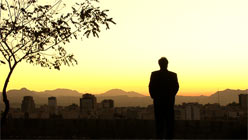U.S.-educated Hossein Kehavarz’s scintillating multi-character drama, Dog Sweat (March 12 at the Kabuki, March 16 at the Viz Cinema), treats us to an ultra-rare and deeply fascinating look at 20-something Iranians. (I was surprised to see an Iranian film in an Asian festival, ’til a gander at an atlas put at least part of this large country in western Asia.) Shot in Tehran — at some risk to the cast and crew, one presumes — the movie interlaces the romantic and familial travails of half a dozen attractive, conflicted and altogether likable characters.
One young woman is sleeping with her cousin’s husband; another is desperate to “have fun” (presumably for the first time) if only she and the designated guy can find some place (a friend’s apartment, for example) to be alone indoors. Another gal wants to be a recording artist, which violates all sorts of unwritten rules.
The guys in Dog Sweat (a euphemism for black-market booze, but it makes for an ill-advised title) include a regular guy, whose party-down facade crumbles when his mother is seriously injured, and a gay man who enters into an arranged marriage. What defines each of the characters and plotlines — no matter how familiar or universal they sound — is the amount of freedom they can carve out, and the degree of secrecy they must maintain.
In its look, structure and rhythms, Dog Sweat much more closely resembles American independent films than the meditative, mysterious movies of Abbas Kiarostami that have come to define Iranian cinema for many of us. But Kehavarz’s winning feature debut distinguishes itself from the vast majority of Amerindies in a crucial way: Every single scene, in addition to illuminating the characters and moving the plot forward, reveals something about the society in which it is set. And that’s the real source of the movie’s fascination.

“Passion”
Mongolian filmmaker Byamba Sakhya’s contemplative documentary, Passion (Khusel Shunel, March 13 at the Kabuki, March 18 at the Pacific Film Archive), is a kind of open-ended meditation on the past and future of movies. His muse, and foil, is Binder Jigjid, a veteran director whose father was one of the top Mongolian directors of the 1950s and ’60s. (Sakhya pays admiring tribute to Jigjid Dejid with numerous clips of his socialist epics, a most pleasurable form of looking back.)
The fall of the USSR, and the end of government-subsidized films, has left Binder Jigjid to deal with the vagaries of capitalism. He still manages to make movies, and the lion’s share of Passion follows him schlepping his latest work (Human Traffic, “based on a true story”) to far-flung towns in the Mongolian steppes. “Unfortunately,” Jigjid says, “the success of our films is dependent on promotion rather than quality.”
Many directors would agree, regardless of their nationality, but few would travel as many kilometers for such sparse audiences. The main payoff from this arduous excursion is lovely landscape shots of snow-blown vistas, and ample opportunity for the filmmaker and his subject to contemplate the future of movies.
Passion has a melancholy soul, as you might expect, but it’s not a downer. The world keeps turning, film artists adapt and audiences still seek them out. Well, at least festival audiences do.
The San Francisco International Asian American Film Festival screens March 10-20, 2011 at San Francisco, Berkeley and San Jose venues. For tickets, a full schedule and more information visit caamedia.org.




